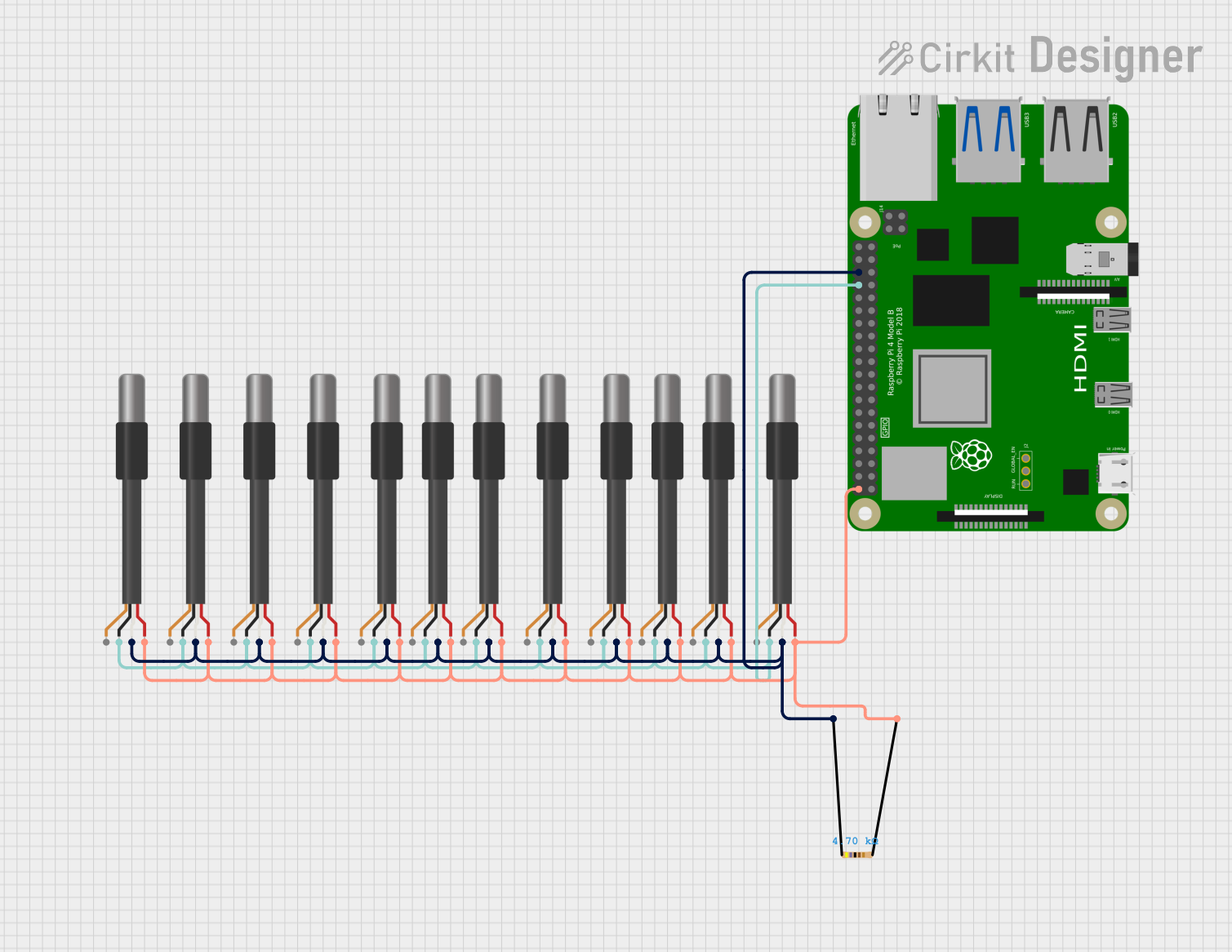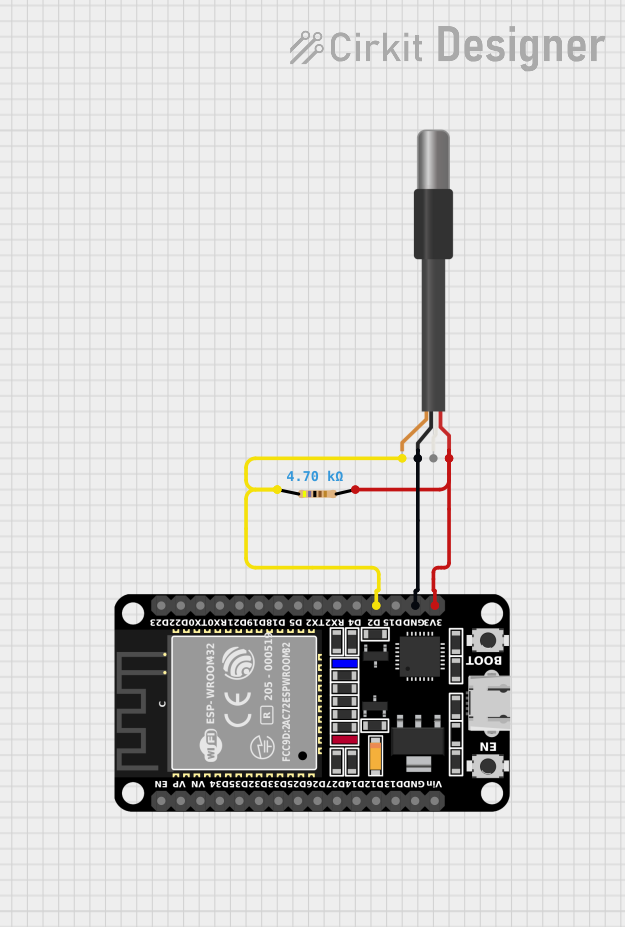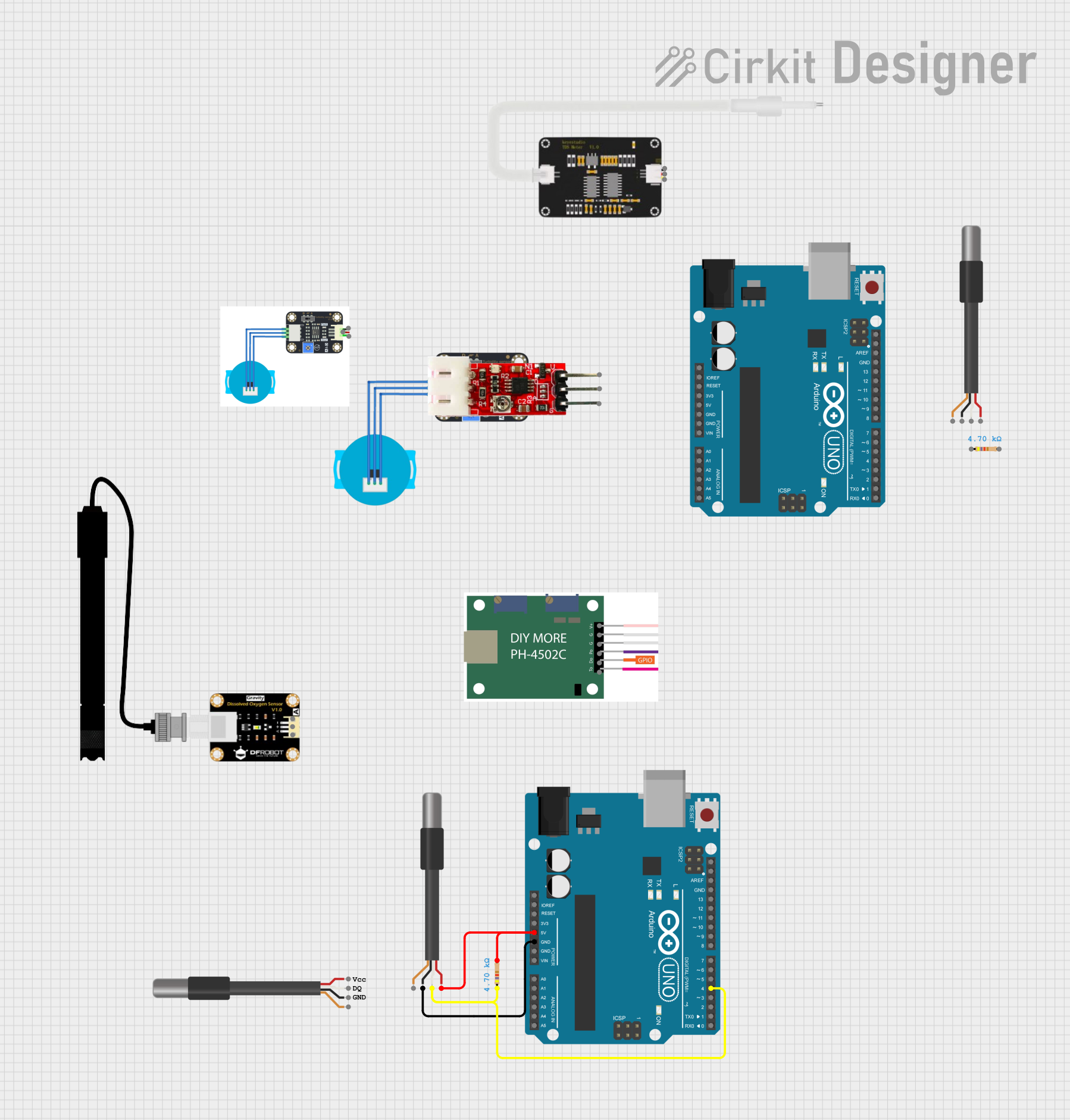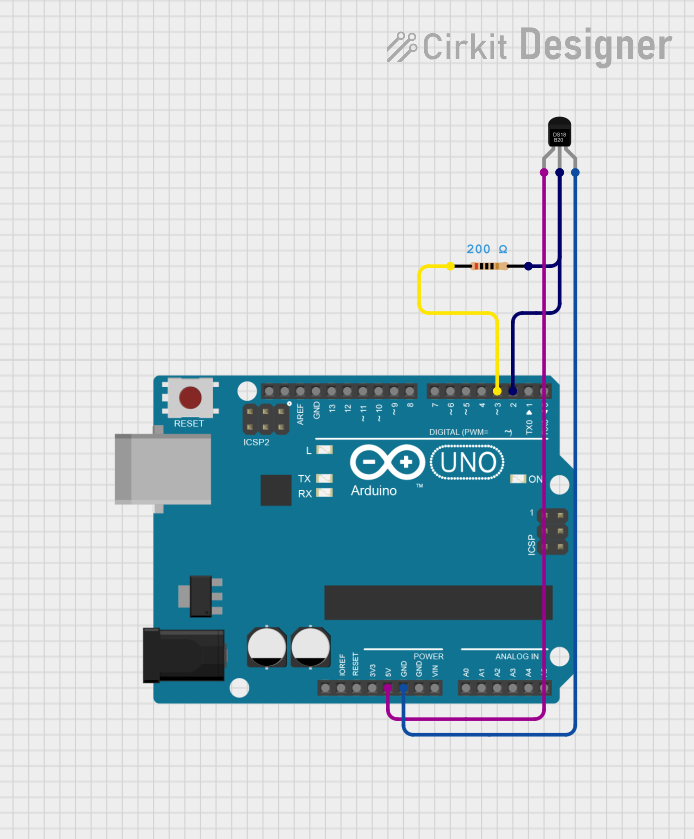
How to Use DS18B20 1-Wire Temperature Sensor Probe Cable: Examples, Pinouts, and Specs

 Design with DS18B20 1-Wire Temperature Sensor Probe Cable in Cirkit Designer
Design with DS18B20 1-Wire Temperature Sensor Probe Cable in Cirkit DesignerIntroduction
The DS18B20 is a digital temperature sensor that provides 9-bit to 12-bit Celsius temperature measurements. The sensor communicates over a 1-Wire bus that by definition requires only one data line (and ground) for communication with a central microprocessor. It has an alarm function with nonvolatile user-programmable upper and lower trigger points. The DS18B20 is widely used in a variety of applications, including HVAC environmental controls, temperature monitoring systems inside buildings, equipment, or machinery, and process monitoring and control systems.
Explore Projects Built with DS18B20 1-Wire Temperature Sensor Probe Cable

 Open Project in Cirkit Designer
Open Project in Cirkit Designer
 Open Project in Cirkit Designer
Open Project in Cirkit Designer
 Open Project in Cirkit Designer
Open Project in Cirkit Designer
 Open Project in Cirkit Designer
Open Project in Cirkit DesignerExplore Projects Built with DS18B20 1-Wire Temperature Sensor Probe Cable

 Open Project in Cirkit Designer
Open Project in Cirkit Designer
 Open Project in Cirkit Designer
Open Project in Cirkit Designer
 Open Project in Cirkit Designer
Open Project in Cirkit Designer
 Open Project in Cirkit Designer
Open Project in Cirkit DesignerCommon Applications
- Home automation systems
- Aquarium temperature monitoring
- Industrial temperature control
- Weather stations
- Food and beverage temperature monitoring
Technical Specifications
Key Technical Details
- Power Supply Range: 3.0V to 5.5V
- Operating Temperature Range: -55°C to +125°C
- Accuracy: ±0.5°C from -10°C to +85°C
- Programmable Resolution: 9-bit to 12-bit
- Unique 64-bit Serial Code Stored in On-Board ROM
- Multi-drop Capability Simplifies Distributed Temperature Sensing Applications
Pin Configuration and Descriptions
| Pin Number | Name | Description |
|---|---|---|
| 1 | GND | Ground |
| 2 | DQ | Data Line |
| 3 | VDD | Power Supply |
Usage Instructions
Integration into a Circuit
- Connect the GND pin to the ground of the power supply.
- Connect the VDD pin to a 3.0V to 5.5V power supply.
- Connect the DQ pin to the data input on your microcontroller.
- Optionally, connect a 4.7kΩ pull-up resistor between the DQ pin and the VDD pin for proper communication on the 1-Wire bus.
Best Practices
- Use a pull-up resistor of 4.7kΩ on the DQ line when connecting to a microcontroller.
- Avoid long wire lengths to minimize the resistance and capacitance on the data line, which can cause communication issues.
- Ensure that the power supply is stable and within the specified voltage range.
Example Code for Arduino UNO
#include <OneWire.h>
#include <DallasTemperature.h>
// Data wire is plugged into pin 2 on the Arduino
#define ONE_WIRE_BUS 2
// Setup a oneWire instance to communicate with any OneWire devices
OneWire oneWire(ONE_WIRE_BUS);
// Pass our oneWire reference to Dallas Temperature sensor
DallasTemperature sensors(&oneWire);
void setup(void)
{
// Start serial communication for debugging
Serial.begin(9600);
// Start up the library
sensors.begin();
}
void loop(void)
{
// Call sensors.requestTemperatures() to issue a global temperature
// request to all devices on the bus
sensors.requestTemperatures();
// Fetch the temperature in degrees Celsius for device index 0
float tempC = sensors.getTempCByIndex(0);
// Check if reading was successful
if(tempC != DEVICE_DISCONNECTED_C)
{
Serial.print("Temperature: ");
Serial.print(tempC);
Serial.println("°C");
}
else
{
Serial.println("Error: Could not read temperature data");
}
delay(1000);
}
Troubleshooting and FAQs
Common Issues
- Temperature Readings Are Inaccurate: Ensure that the DS18B20 is not placed near heat-generating components and that the correct pull-up resistor is used.
- No Data on the Bus: Check the connections and the pull-up resistor on the DQ line. Ensure that the microcontroller's data pin is correctly configured.
- Fluctuating Readings: Stabilize the power supply and avoid long wires that can introduce noise.
FAQs
Q: Can I connect multiple DS18B20 sensors to the same data line?
A: Yes, the DS18B20 supports multi-drop capability, allowing multiple sensors to be connected on the same 1-Wire bus.
Q: How do I set the resolution of the temperature measurements?
A: The resolution can be set programmatically using the DallasTemperature library functions. Refer to the library documentation for specific instructions.
Q: What is the purpose of the unique 64-bit serial code?
A: The unique serial code allows for the identification of each sensor on a shared 1-Wire bus, which is essential for addressing specific sensors in a multi-sensor setup.
Q: How long can the cable be between the sensor and the microcontroller?
A: The maximum cable length depends on the quality of the cable and the pull-up resistor value. For longer cables, a lower value resistor may be needed to maintain signal integrity. Keep the cable as short as practical to ensure reliable communication.